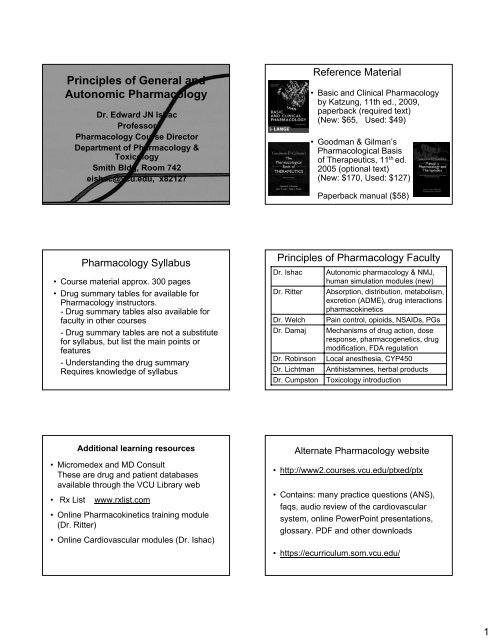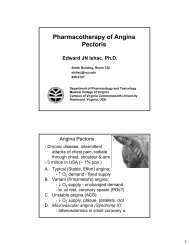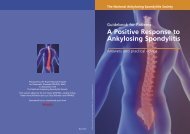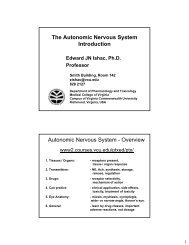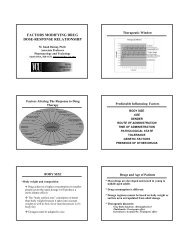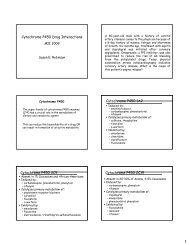Principles of General and Autonomic Pharmacology
Principles of General and Autonomic Pharmacology
Principles of General and Autonomic Pharmacology
You also want an ePaper? Increase the reach of your titles
YUMPU automatically turns print PDFs into web optimized ePapers that Google loves.
<strong>Principles</strong> <strong>of</strong> <strong>General</strong> <strong>and</strong><br />
<strong>Autonomic</strong> <strong>Pharmacology</strong><br />
Dr. Edward JN Ishac<br />
Pr<strong>of</strong>essor<br />
<strong>Pharmacology</strong> Course Director<br />
Department <strong>of</strong> <strong>Pharmacology</strong> &<br />
Toxicology<br />
Smith Bldg, Room 742<br />
eishac@vcu.edu, x82127<br />
Reference Material<br />
• Basic <strong>and</strong> Clinical <strong>Pharmacology</strong><br />
by Katzung, 11th ed., 2009,<br />
paperback (required text)<br />
(New: $65, Used: $49)<br />
• Goodman & Gilman’s<br />
Pharmacological Basis<br />
<strong>of</strong> Therapeutics, 11 th ed.<br />
2005 (optional text)<br />
(New: $170, Used: $127)<br />
Paperback manual ($58)<br />
<strong>Pharmacology</strong> Syllabus<br />
• Course material approx. 300 pages<br />
• Drug summary tables for available for<br />
<strong>Pharmacology</strong> instructors.<br />
- Drug summary tables also available for<br />
faculty in other courses<br />
- Drug summary tables are not a substitute<br />
for syllabus, but list the main points or<br />
features<br />
- Underst<strong>and</strong>ing the drug summary<br />
Requires knowledge <strong>of</strong> syllabus<br />
<strong>Principles</strong> <strong>of</strong> <strong>Pharmacology</strong> Faculty<br />
Dr. Ishac<br />
Dr. Ritter<br />
Dr. Welch<br />
Dr. Damaj<br />
Dr. Robinson<br />
Dr. Lichtman<br />
Dr. Cumpston<br />
<strong>Autonomic</strong> pharmacology & NMJ,<br />
human simulation modules (new)<br />
Absorption, distribution, metabolism,<br />
excretion (ADME), drug interactions<br />
pharmacokinetics<br />
Pain control, opioids, NSAIDs, PGs<br />
Mechanisms <strong>of</strong> drug action, dose<br />
response, pharmacogenetics, drug<br />
modification, FDA regulation<br />
Local anesthesia, CYP450<br />
Antihistamines, herbal products<br />
Toxicology introduction<br />
Additional learning resources<br />
• Micromedex <strong>and</strong> MD Consult<br />
These are drug <strong>and</strong> patient databases<br />
available through the VCU Library web<br />
• Rx List www.rxlist.com<br />
• Online Pharmacokinetics training module<br />
(Dr. Ritter)<br />
• Online Cardiovascular modules (Dr. Ishac)<br />
Alternate <strong>Pharmacology</strong> website<br />
• http://www2.courses.vcu.edu/ptxed/ptx<br />
• Contains: many practice questions (ANS),<br />
faqs, audio review <strong>of</strong> the cardiovascular<br />
system, online PowerPoint presentations,<br />
glossary. PDF <strong>and</strong> other downloads<br />
• https://ecurriculum.som.vcu.edu/<br />
1
Examinations <strong>and</strong> Grading<br />
Faculty<br />
• Final grade is determined by your<br />
performance on all pharmacology questions<br />
during the year 2010-11<br />
• <strong>Pharmacology</strong> questions are identified on<br />
each exam (Pharmtox). Questions will count<br />
as part <strong>of</strong> your grade in each course (GI,<br />
CNS, Renal, etc.,) <strong>and</strong> then combined to<br />
determine your final pharmacology grade.<br />
Name<br />
Balster<br />
Costanzo<br />
Damaj<br />
Gewirtz<br />
Hylemon<br />
Ishac<br />
Nicholson<br />
Course<br />
Behavioral<br />
Renal<br />
<strong>Principles</strong><br />
Hem/Oncology<br />
Microbiology<br />
<strong>Principles</strong><br />
Cardiovascular<br />
Microbiology<br />
Name<br />
Lichtman<br />
Cumpston<br />
Ritter<br />
Robinson<br />
Miles<br />
Akbarali<br />
Welch<br />
Course<br />
<strong>Principles</strong><br />
<strong>Principles</strong><br />
<strong>Principles</strong><br />
Cardiovascular<br />
<strong>Principles</strong><br />
Respiratory<br />
GI<br />
<strong>Principles</strong><br />
Womens Health<br />
M2 Course<br />
<strong>Pharmacology</strong> Questions (Pharmtox)<br />
<strong>Pharmacology</strong><br />
Pathogenesis<br />
Microbiology<br />
Hematology<br />
Endocrine<br />
Renal<br />
Respiratory<br />
Cardiovascular<br />
Central Nervous System<br />
Behavioral Sciences<br />
Women’s Health<br />
GI<br />
Musculoskeletal<br />
Total Questions<br />
2009-10<br />
99<br />
4<br />
42<br />
12<br />
17<br />
20<br />
9<br />
26<br />
14<br />
25<br />
19<br />
5<br />
10<br />
303<br />
(1FCM)<br />
2008-09<br />
100<br />
4<br />
39<br />
12<br />
15<br />
21<br />
8<br />
36<br />
13<br />
25<br />
19<br />
9<br />
10<br />
311<br />
2007-08<br />
100<br />
4<br />
46<br />
17<br />
20<br />
22<br />
8<br />
28<br />
24<br />
28<br />
17<br />
10<br />
15<br />
339<br />
2006-07<br />
104<br />
4<br />
39<br />
15<br />
17<br />
22<br />
8<br />
30<br />
22<br />
27<br />
18<br />
11<br />
15<br />
332<br />
Exam Results 2009-10<br />
Total pharmacology questions in various<br />
courses = 303 (class avg = 85.9)<br />
Total all M-II questions 1420<br />
(class avg = 84.2 – 89.8)<br />
<strong>Pharmacology</strong> % <strong>of</strong> total – 21.4%<br />
2009-10: Honors (33) High Pass (75)<br />
Pass (85) Marginal (0)<br />
Fail (0) Incomplete (1)<br />
<strong>Pharmacology</strong> Examination<br />
• Exam will be on Friday Aug. 6 th in MSB<br />
• Curriculum <strong>of</strong>fice will announce time & duration<br />
• It will be a paper exam not electronic<br />
• The test will be multiple choice questions<br />
• It will consist <strong>of</strong> 100 MCQs, no True/False<br />
• You should bring a calculator; PDAs not allowed<br />
• Contains reference value table (back)<br />
• Most questions in USMLE Step 1 format<br />
• Drug trade names not included nor required<br />
Pharmacokinetics & Cardiovascular Review<br />
Session (Optional)<br />
• Friday July 30th, 12 noon in Baruch (optional)<br />
• Dr. Ritter:<br />
• Review principles <strong>of</strong> Pharmacokinetics (ADME)<br />
• Online Pharmacokinetics self-learn module (access<br />
through eCurriculum)<br />
• Monday Aug. 2nd, 12 noon in Baruch (optional)<br />
• Dr. Ishac: Review autonomic agents <strong>and</strong> their effect<br />
on the cardiovascular system<br />
• http://www2.courses.vcu.edu/ptxed/ptx/cardiov<br />
ascular.htm<br />
2
Neuromuscular Blocking Agents - TBL<br />
• Dr. Ishac<br />
• Team-based Learning (TBL) session<br />
• Tuesday Aug 3rd, 9:40am-11am<br />
• Use <strong>of</strong> “Clickers”<br />
• Use M-I group assignments<br />
• Complete reading assignment before class<br />
• Individual MCQ (6) test<br />
• Group MCQ test (same 6 questions)<br />
• MCQ question discussion appeal<br />
• <strong>General</strong> discussion question by group<br />
• Review <strong>of</strong> material<br />
Human Simulation Module<br />
• Drs. Ishac & Cumpston (ANS & Toxicology)<br />
• Optional Manikin simulation modules<br />
• Sign-up online (see eBoard) by Wed Jul 28 th , 10pm<br />
• North Hospital, 2 nd Floor, B218 (staging area)<br />
• Held Tue Aug 3rd, 12:40pm-5pm (20 min<br />
simulation session followed by 15 min debriefing)<br />
• Team groups <strong>of</strong> 8 for simulation module<br />
• Bonus <strong>of</strong> 1 point towards your <strong>Pharmacology</strong><br />
examination for participation (sign-out)<br />
• Includes 1 Pharmacy student per group<br />
• Presented with 1 module <strong>of</strong> 10 for simulation<br />
• Reinforce concepts from class<br />
Tips for Drug Learning<br />
• Learn agents by drug classes<br />
ie. beta-blockers, Ca ++ -blockers etc<br />
• Key points:<br />
- Clinical application<br />
- Mechanism <strong>of</strong> action<br />
- Drug <strong>of</strong> choice (DOC)<br />
ie. epinephrine (anaphylaxis)<br />
- Prototype drugs, most common agents<br />
ie. propranolol, atenolol, metoprolol<br />
- Important drug/drug interactions<br />
ie. MAO inhibitors & tyramine rich food<br />
- Adverse drug reactions<br />
ie. beta-blockers – asthma, Raynaud’s D.<br />
- Do not focus on dosage, know high/low Rx<br />
Typical / Ideal Step 1 Exam Question<br />
A 42-old woman who is a biochemist is<br />
brought to the emergency department<br />
because <strong>of</strong> a 1-hour history <strong>of</strong> severe<br />
abdominal cramps, nausea, vomiting,<br />
sweating, <strong>and</strong> difficulty breathing due to<br />
bronchospasm <strong>and</strong> congestion. On<br />
physical examination her pulse is<br />
45/min, BP is 85/50 mm Hg <strong>and</strong> she<br />
exhibits generalized muscle weakness.<br />
Laboratory studies show no<br />
abnormalities. Exposure to which <strong>of</strong> the<br />
following is most likely?<br />
A. atropine<br />
B. bethanechol<br />
C. botulinum toxin<br />
D. is<strong>of</strong>lurophate<br />
E. phentolamine<br />
Stem order<br />
Patient details<br />
Presenting problem<br />
History<br />
Physical exam<br />
Laboratory findings<br />
Initial treatment<br />
Subsequent findings<br />
Option lead-in<br />
(No negative lead-in)<br />
Options<br />
Cover-up rule<br />
Homogenous (tests, Rx)<br />
Balanced (↑ or ↓)<br />
Plausible<br />
Similar length<br />
Alphabetical<br />
Typical / Ideal Exam Question Type F 1d<br />
A 52-old man undergoes a right<br />
total hip replacement. During the<br />
procedure, the patient experiences<br />
a flaccid muscle paralysis <strong>and</strong> a<br />
decrease in blood pressure<br />
following the administration <strong>of</strong> the<br />
neuromuscular blocking drug.<br />
Which <strong>of</strong> the following<br />
neuromuscular drugs was most<br />
likely administered in this patient?<br />
A. atracurium<br />
B. mivacurium<br />
C. pancuronium<br />
D. rocuronium<br />
E. succinylcholine<br />
F. tubocurarine<br />
Rules ?<br />
Two questions<br />
Same stem<br />
No return to 1 st MCQ<br />
No extra information<br />
Answers not dependent<br />
Different lead in<br />
Options<br />
Cover-up rule<br />
Homogenous (tests, Rx)<br />
Balanced (↑ or ↓)<br />
Plausible<br />
Similar length<br />
Alphabetical<br />
Typical / Ideal Exam Question Type F 1e<br />
A 52-old man undergoes a right total hip<br />
replacement. During the procedure, the patient<br />
experiences a flaccid muscle paralysis <strong>and</strong> a<br />
decrease in blood pressure following the<br />
administration <strong>of</strong> the neuromuscular blocking drug.<br />
At the end <strong>of</strong> the operation, a drug is administered<br />
to reverse the muscle paralysis. This drug was<br />
most likely which <strong>of</strong> the following?<br />
A. atropine<br />
B. dantrolene<br />
C. neostigmine<br />
D. pancuronium<br />
E. physostigmine<br />
F. succinylcholine<br />
3
Drug Extensions I<br />
Drug Extensions II<br />
Beta-blockers<br />
-olol<br />
propranolol<br />
atenolol<br />
Alpha1-blockers<br />
ACE inhibitors<br />
-azosin<br />
-pril<br />
prazosin<br />
captopril<br />
terazosin<br />
lisinopril<br />
Thrombolytics<br />
Corticosteroids<br />
-ase<br />
-plase<br />
-sone<br />
streptokinase<br />
prednisone<br />
reteplase<br />
dexamethasone<br />
A-II blockers (ARBs)<br />
NMJ blockers<br />
Ca Channel blockers<br />
HMG CoA reductase<br />
inhibitors (statins)<br />
-sartan<br />
-curium<br />
-dipine<br />
-vastatin<br />
losartan<br />
atracurium<br />
nifedipine<br />
atorvastatin<br />
valsartan<br />
rocuronium<br />
nicardipine<br />
simvastatin<br />
Protein pump<br />
inhibitors<br />
H2-blockers<br />
Benzodiazephines<br />
-prazole<br />
-tidine<br />
-zepam<br />
-zolam<br />
omeprazole<br />
cimetidine<br />
diazepam<br />
loprazolam<br />
lansoprazole<br />
ranitidine<br />
lorazepam<br />
alprazolam<br />
Antifungals<br />
Drug Extensions III –<br />
Antibiotics/Antifungal Agents<br />
Aminoglycosides<br />
Macrolides<br />
Fluroquinolones<br />
Tetracyclines<br />
Cephalosporins<br />
Penicillins<br />
-azole<br />
-micin,<br />
-mycin<br />
-thromycin<br />
-floxacin<br />
-cycline<br />
cef-, ceph-<br />
-cillin<br />
miconazole<br />
gentamicin<br />
erythromycin<br />
cipr<strong>of</strong>loxacin (2)<br />
doxycycline<br />
cefaclor (2)<br />
penicillin G<br />
itraconazole<br />
streptomycin<br />
azithromycin<br />
lev<strong>of</strong>loxacin (3)<br />
oxytetracycline<br />
cefdinir (3)<br />
penicillin V<br />
1A2<br />
2E1<br />
2C9<br />
2C19<br />
2D6<br />
3A4<br />
Main Cytochrome P450 Enzymes<br />
Inhibitors<br />
Amiodarone, cimetidine,<br />
cipr<strong>of</strong>loxacin, fluvoxamine<br />
Disulfirum<br />
Amiodarone, fluoxetine,<br />
metronidazole,<br />
trimethoprim/sulfamethoxazole<br />
Isoniazid, ritonavir,<br />
fluvoxamine<br />
Amiodarone, cimetidine,<br />
diphenhydramine, ritonavir,<br />
fluoxetine<br />
Diltiazem, grapefruit, verapamil,<br />
erythromycin, clarithromycin,<br />
ritonavir, ketoconazole<br />
Inducers<br />
Carbamazepine,<br />
smoking, rifampin,<br />
phenobarbital<br />
Alcohol, isoniazid<br />
Carbamazepine,<br />
phenytoin,<br />
phenobarbital, rifampin<br />
Carbamazepine,<br />
phenytoin, rifampin<br />
No significant inducers<br />
Carbamazepine,<br />
phenytoin,<br />
phenobarbital, rifampin,<br />
St. John’s wort<br />
Substrates<br />
Caffeine, tizanidine,<br />
theophylline,<br />
r-warfarin<br />
Acetaminophen<br />
Carvedilol, ARB,<br />
s-warfarin,<br />
fluvastatin<br />
Omeprazole,<br />
phenytoin,<br />
phenobarbital<br />
Carvedilol,<br />
amitriptyline,<br />
codeine, metoprolol<br />
CCBs, statins,<br />
zolpidem, r-warfarin,<br />
prednisone,<br />
saquinavir, estrodiolcontraceptives<br />
Agent<br />
Lead<br />
Arsenic<br />
Iron<br />
Mercury<br />
Carbon<br />
monoxide<br />
Copper<br />
Cyanide<br />
Symptoms<br />
Toxicity I<br />
Vomiting, nausea, diarrhea, gingival bluish line<br />
(Burton line), weakness extensor muscles (wrist<br />
drop), microcytic hypochromic anemia, ab. pain<br />
Vomiting, neuropathy, microcytic hypochromic<br />
anemia, diarrhea, alopecia, hyperpigmentation<br />
Vomiting with blood, lethargic, ab. pain, ↑ferritin,<br />
high anion gap metabolic a. (prenatal supp.)<br />
Vomiting, abdominal pain, hyperhydrosis, ataxia,<br />
↑HR, muscle weakness, ↑NE/EPI (↓metab.), red<br />
cheeks/fingers/toes, lethargy, renal toxicity<br />
Headache, blurred vision, nausea, fatigue, red<br />
lips/fingers, ↑carboxyhemoglobin, tachycardia<br />
Headache, tremor, rigidity, difficulty swallowing,<br />
irritable, confused, ↑AST/ALT, ↑ceruloplasmin<br />
(ferroxidase), renal toxicity, hemolysis, ab. pain<br />
Muscle weakness, hypotension, high anion gap<br />
metabolic acidosis, dysrhythmias, dyspnea,<br />
seizures, bitter almond odor, ↑plasma lactate<br />
Treatment<br />
Succimer<br />
(Ca-EDTA,<br />
Dimercaprol)<br />
Fluid replacement<br />
<strong>and</strong> Dimercaprol<br />
Deferoxamine<br />
Dimercaprol<br />
Hyperbaric oxygen,<br />
Oxygen<br />
D-Penicillamine,<br />
(Dimercaprol)<br />
Na nitrite/Amyl nitrite,<br />
Hydroxycobalamin,<br />
Na Thiosulfate<br />
Agent<br />
Organophosphate<br />
Belladonna<br />
alkaloids<br />
Nitrates<br />
Methanol<br />
Ethylene<br />
glycol<br />
Warfarin<br />
Amiodarone<br />
Symptoms<br />
Toxicity II<br />
sludgebam, muscle weakness, salivation<br />
sweating, miosis, lacrimation, urination,<br />
diarrhea, bronchospasm, bradyacardia, cramps<br />
Dry mouth, blurred vision, mydriasis,<br />
tachycardia, flushing, delirium, convulsions,<br />
urinary retention, constipation, confusion<br />
Headache, dizziness, chest pain, tachycardia,<br />
hypotension, methemoglobin, hemolysis<br />
Nausea, vomiting, intoxication, blurred vision,<br />
ataxia, ↑plasma formic acid, high anion gap<br />
metabolic a., ↑osmolality gap<br />
Slurred speech, nausea, vomiting, confusion,<br />
uncoordinated, lethargic, resting tremor, anion<br />
gap m. acidosis, ↑osmolar gap, intoxication<br />
Ecchymoses, easy bruising, hematuria, anemia,<br />
dark stools, bleeding gums, ↑PT/INR<br />
Diffuse crackles, wheezing, pulmonary fibrosis,<br />
↓HR, prolonged QT, wide QRS, hypothyroidism,<br />
cardiac depression, photosensitivity, bluish skin<br />
Treatment<br />
Atropine <strong>and</strong><br />
Pralidoxime (2-<br />
PAM)<br />
Cholinesterase<br />
inhibitor ie.<br />
Physostigmine<br />
Methylene blue<br />
Fomepizole<br />
Fomepizole<br />
Stop drug<br />
Stop drug<br />
4


